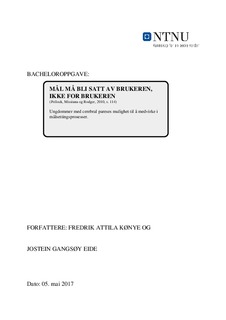| dc.contributor.advisor | Stigen, Linda | |
| dc.contributor.author | Kønye, Fredrik Attila | |
| dc.contributor.author | Eide, Jostein Gangsøy | |
| dc.date.accessioned | 2017-08-15T06:52:50Z | |
| dc.date.available | 2017-08-15T06:52:50Z | |
| dc.date.issued | 2017 | |
| dc.identifier.uri | http://hdl.handle.net/11250/2450674 | |
| dc.description.abstract | Problemstilling: Hvordan arbeider kommunale ergoterapeuter slik at ungdom 12 - 18 år med cerebral parese har mulighet til å medvirke i målsettingsprosesser? Metode: Kvalitativ metode ble anvendt som forskningsstrategi, ved bruk av semistrukturerte intervjuer av tre kommunale ergoterapeuter. Intervjuene ble analysert ved bruk av kvalitativ innholdsanalyse og hovedtemaer ble identifisert. Resultat: Resultatene fra intervjuene viser at de kommunale ergoterapeutene arbeider for å skape et tillitsforhold med ungdommen over tid, og de bruker dette som et fundament for målsettingsprosessene. Ergoterapeutene forteller at de aktivt arbeider for å la ungdommen medvirke ved å vektlegge ungdommens ønsker under målsettingsprosessene, og bygger videre på ungdommens mål ved å dele opp og konkretisere målene til ungdommen. Diskusjon: Resultatet og funnene fra intervjuene ble diskutert opp mot relevant forskning og teori, og ergoterapeutenes utsagn ble gjort rede for og satt opp mot hverandre. Konklusjon: Funnene i denne oppgaven viser at de kommunale ergoterapeutene arbeider for å bygge et gjensidig tillitsforhold med ungdommen over tid, gjør ungdommen til en aktiv deltager i målsettingsprosessene, og har et helsefremmende perspektiv hvor de legger stort fokus på å underbygge ungdommens motivasjon, ved at mål blir satt av ungdommen, ikke for ungdommen. | nb_NO |
| dc.description.abstract | Issue: How does public occupational therapists work so that adolescents 12 - 18 years with cerebral palsy have the opportunity to contribute in goal setting processes? Method: Qualitative method was used, and semi-structured individual interviews was conducted with three public working occupational therapists. The interviews were analyzed by the usage of qualitative content analysis and the main themes were identified. Results: The results from the interviews shows that the public occupational therapists are working towards creating a trusting relationship with the adolescents over time, and uses this as a foundation for the goal setting processes. The occupational therapists explains that they actively work towards letting the adolescents become involved, by focusing upon the adolescents wishes when conducting goals, and are building upon the goals of the adolescents, by picking apart, and concretizing the goals of the adolescents. Discussion: The results and findings from the interviews were discussed against relevant research and literature, and the respondents' statements was accounted for and set up against each other. Conclusion: The findings in this study shows that the public occupational therapists are working towards building a mutual trusting relationship with the adolescents over time, makes the adolescents an active participant in the goal setting processes, and has a perspective towards health promotion by focusing on building upon the adolescents motivation, so that goals are set by the adolescent, not for the adolescent. | nb_NO |
| dc.language.iso | nob | nb_NO |
| dc.subject | ergoterapi | nb_NO |
| dc.subject | cerebral parese | nb_NO |
| dc.subject | ungdom | nb_NO |
| dc.title | Mål må bli satt av brukeren, ikke for brukeren: ungdommer med cerebral pareses mulighet til å medvirke i målsettingsprosesser | nb_NO |
| dc.title.alternative | Goals need to be set by the client, not for the client: adolescents with cerebral palsys opurtunity to participate in goal setting processes | nb_NO |
| dc.type | Bachelor thesis | nb_NO |
| dc.subject.nsi | VDP::Medical disciplines: 700::Clinical medical disciplines: 750::Neurology: 752 | nb_NO |
| dc.source.pagenumber | 49 | nb_NO |
